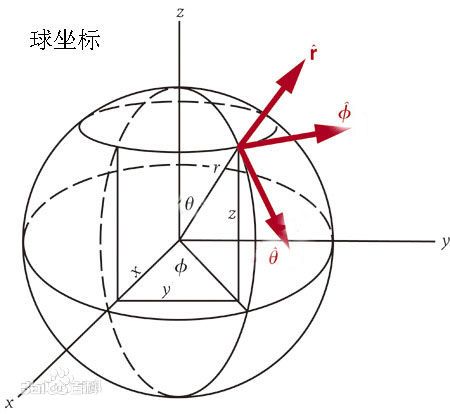坐标变换与其它常用坐标系
空间解析几何
|
张瑞
中国科学技术大学数学科学学院
rui@ustc.edu.cn |
坐标变换与其它常用坐标系
坐标变换
空间中,两个不同的右手直角坐标系,其中一个可以通过平移与旋转与另一个重合。
- 设和是 空间中两个不同的右手直角坐标系。
- 点在两个坐标系下的坐标分别是和。
- 下面,来看两个坐标之间的关系。
平移
设和的坐标系坐标轴方向相同,原点不同,即, , , 。 且有
注意到,
- 并设(即在坐标系下的坐标是,则有
得到平移坐标变换公式
例 1. 下面方程刻画的是什么图形
解. 配方,原方程变为
将坐标原点平移到,即取
代入得到
是个(旋转)椭球面。
旋转
设两个右手直角坐标系和的原点相同,但坐标轴方向不同。
|
利用方向余弦表示,知道
又, , 两两正交,因此对成立
点在两个坐标系下的坐标分别是和,则有
由线性代数的知识,存在正交阵,成立
若点在两个坐标系下的坐标分别是和,则有
得到旋转坐标变换公式:
同样,有
由正交,因此
则有
当一个轴不动时(如轴不动),则有
|
绕轴逆时针旋转后 坐标转换公式为 |
绕轴顺时针旋转后 坐标转换公式为 |
例 2. 将直角坐标系绕轴逆时针旋转后,得到新坐标系。 试表示新旧坐标间的变换关系,并给出方程在新坐标系下的表达式
解. 依题意,有
代入方程后,得到 ,
即有 是一个马鞍面。
注意到标准二次曲面方程中,不含, , 等项,需要在新坐标下的表达式中去掉这类项。令,且
代入方程,有
取,则有
例 3. 利用坐标变换化简方程
并指出它是什么曲面。
解. 注意到标准二次曲面方程中,不含, , 等项,需要在新坐标下的表达式中去掉这类项。
令,且
则变成
取合适的, ,使
即,坐标变换公式为
代入后,有
配方
坐标平移
是一个双叶双曲面。
对于更一般的表达式
令 , 则系数满足:
-
如下6个表达式
-
如下3个表达式。
代入后,得到, , 的系数为。
更好的方法,在线性代数课程中介绍。
其它常用坐标系
前面介绍的坐标系,是由一个原点和三个不共面的向量组成。这样的空间坐标系是线性坐标系, 它的一个坐标分量等于常量所对应的面都是平面。
下面介绍一些常见的非线性坐标系。
平面的极坐标系
定义 1.
平面上的极坐标系可以按如下方法构造,
- 在平面上取定一点(称为极点),
- 从极点引一条射线(称为极轴),
- 再选定一个长度单位和角度的正向(通常取逆时针方向为正)
这样就构成的平面上的极坐标系。
对于平面上任意一点,
|
则数组可以确定点在空间的位置,并称为点的极坐标。
在直角坐标中,取为极点,轴为极轴。 则平面上任意一点的直角坐标和极坐标的变换关系为
|
的位置向量可以表示为 |
极坐标下,平面上的曲线可以表示为 , 或者
例 4. 易知,
- 是平面上以为圆心,半径为的圆,
- 是从出发,沿方向的射线。
例 5. 圆的极坐标表示为?
|
|
柱坐标系
在空间坐标系中,将平面坐标换成极坐标。
定义 2.
即空间中点用坐标来表示,其中
其中, , 。
这样给出了空间的柱坐标系。 称为点的柱坐标。
例 6. 在柱坐标中,
- 表示一个圆柱面,
- 表示以轴为边的半平面。
球坐标系
|
设位置向量与轴的夹角为, 在平面上的投影向量是, 则有 |
将用平面的极坐标来表示,设辐角是,则有
记,则,从而有
|
即有 其中, , 。 |
称为的球坐标,形成的坐标系是球坐标系。
例 7. 球的一些其它表示方式
|
参数方程
平面上圆的参数表示
平面上椭圆的参数表示
类似可以得到空间球面及椭球面的参数表示
空间中,球面的参数表示
空间中椭球面的参数表示
例 8. 通过两曲面和的交线,而母线平行于轴的柱面方程。 GeogeBra
解. 母线平行于轴,则所求柱面与平面的交线就是所求的柱面方程。
而是曲线在平面的投影。将曲线方程
消去变量即为曲线在平面上的投影
得到
为双曲线,也是所求的柱面方程。
例 9. 已知球面过点且与平面的交为圆。求球面的方程
解. 球与平面的相交为圆,且球心在平面的过圆心的法线上。
由题意,球心的坐标为。
同时,球心与点及圆周上的任意一点(如)的距离相等,
得到
球心为,半径为
例 10. 求直线在平面上的投影直线的方程, 并求绕轴旋转一周所成的曲面的方程。
|
如图,设的方向向量为,的方向向量为,的法向量为。则
|
则满足
由题设
得到,即有
可以取方向
另外,过直线与平面的交战,则有
得到
得到投影直线,过点,方向,它的方程为
下面,求绕轴旋转得到的曲面的方程。
设在曲面上,它是由直线上的点旋转得到。
- 取转轴(轴)上的任意一点,如
- 有
- 与转轴(轴)垂直
可以得到
由在上,
将代入上式,有
代入(*)式,可以得到旋转面方程为
整理后,得到
为单叶双曲面。
谢谢

|
在曲线上取两点和,其横坐标分别为与, 则两点的距离为 |
本节读完
例 11. 谢
11.
求过点(0,-3,1)且与Oxy平面的交为圆的球面的方程
https://mooc1-api.chaoxing.com/ananas/latex/render?callback=jQuery1720304907071950090371646293920428&formula=x%5E2%2By%5E2%2B4z%5E2%3D1&=1646293944636